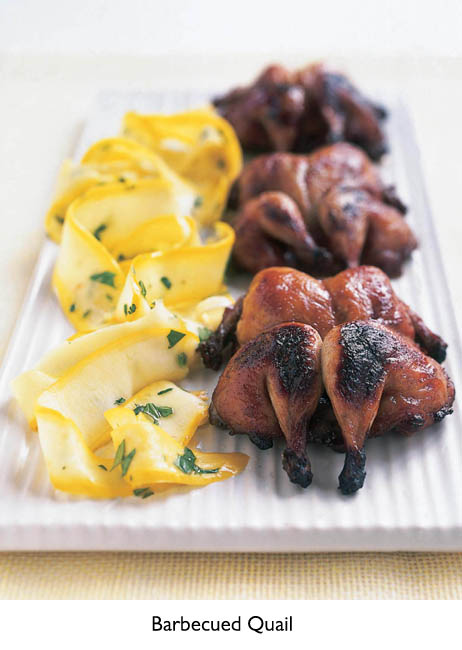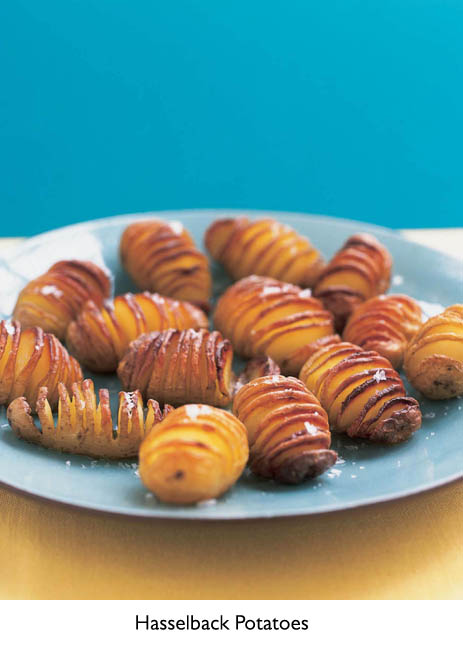Forever Summer (20 page)
Authors: Nigella Lawson

CHICKEN AND CASHEW NUT CURRY
This is the softest, most mellow of curries, by which I don’t mean so much that it’s mild but that it has a gently lapping warmth rather than fierce bite. I always need to keep the chilli content relatively high – I can’t see the point in an entirely toothless Ruby Murray – but the Southern Indian notes of cardamom and coconut milk, and the waxy fatness of the cashews, the soured cream added at the end, keep it calm and voluptuously resonant. I like this with a bowlful of basmati rice, cooked plain save for some bruised cardamom pods added along with the water.
3 tablespoons groundnut oil
2 small onions, finely chopped
salt
2cm fresh ginger, minced
1 fat clove garlic, minced
2 small green chillies, deseeded and finely chopped
1 teaspoon turmeric
1 teaspoon ground cumin
1 teaspoon ground coriander
1 x 400ml tin coconut milk
250ml strongly flavoured chicken stock (I use bouillon concentrate made up with water)
4 cardamom pods, bruised
1kg boned, skinned chicken thighs, cut into bite-sized pieces
200g fine beans, topped, tailed and halved
125g cashew nuts
3 tablespoons soured cream
small bunch fresh coriander, chopped
Heat the oil in a wide saucepan and fry the onions gently, sprinkled with a little salt to stop them burning, until softened and then add the ginger, garlic, chillies, turmeric, cumin and coriander and cook, stirring, for another minute or so.
Stir the coconut milk and stock into the onion spice paste and when everything is incorporated add the cardamom and chicken pieces. Bring the curry back to the boil and then turn down the heat and simmer gently for about 10 minutes or until the chicken is just about cooked through. Check the seasoning and add the fine beans, cooking for another 5 minutes or so. While you’re waiting for them to cook, toast the cashew nuts in a dry frying pan until coloured a little, then tip in the cashew nuts and stir in the soured cream and half of the chopped coriander. Ladle into bowls, sprinkling with more of the coriander as you go.
Serves 6.
GINGERY DUCK WITH RED ONION AND ORANGE SALAD
You can sneer all you like about duck à l’orange but that bird, this fruit: they do go together. And I love the combination this way: the
magrets
steeped in ginger and orange and quickly fried or grilled and just sliced thinly, while still pink within, to ooze their robust juices over some finely sliced red onions and salt-sprinkled oranges. An old idea, maybe, but so fresh – and a whole lot easier than the méthode originale.
2 duck breasts
for the marinade:
juice and zest of 1 orange
1cm fresh ginger, minced
1 small red onion, roughly chopped
for the salad:
2 red onions
4 navel oranges
Maldon salt
small bunch fresh parsley finely chopped (or coriander)
Slash the fat on the duck breasts in diagonals, then put them in the mixed marinade ingredients for about an hour.
Peel, halve and slice the red onions for the salad into very thin half-moons and put them in a bowl. Cut off the top and bottom of the oranges, then, using a small knife, cut vertically around each one to remove the skin and pith. Halve each orange, cut into slices and tip, with all the juice they make as you slice them, into the bowl with the onion.
Leave this orange and onion mixture to steep while you fry the duck. Heat a dry frying pan and put the meat in skin side down. Cook for about 15 minutes in total, turning the duck periodically so that both sides are well coloured; obviously small duck breasts will need less time.
Leave the duck to rest while you arrange the salad on a large flat plate and give a good sprinkle with Maldon salt. Slice the meat thinly on the diagonal and lay the slices on top of the orange and onion. Pour over any orangey, gingery, bloody juices and sprinkle robustly with parsley – or, if you prefer, coriander.
Serves 4.
BARBECUED QUAIL
I love these sweet and meaty quail, conker-shiny in their vaguely Chinesey marinade. As often as not, I grill them rather than barbecue them; even a blitz in a very hot oven will do. The thing is to marinate them for a good long time – at least 24 hours – so that they keep fleshy and juicy and meltingly tender no matter how brutally you cook them.
10 quail
For the marinade:
125ml soy sauce
6 tablespoons roasted sesame oil
1 x 250g jar hoisin sauce
3 tablespoons rice vinegar
5cm knob fresh ginger, minced
2 cloves garlic, minced
juice of 1 orange
You need the quail to be spatchcocked which is, given their poor little frail bones, a very easy job. First trim their wing tips with a pair of kitchen shears or, frankly, scissors, then cut along both sides of the backbone, remove it, and squish each quail down flat.
Mix all the ingredients for the marinade in a large measuring jug, whisk to mix, then divide the mixture between two large freezer bags. Chuck in the flattened quail, half in each, then tie up the bags; or you can simply lay the quail in a couple of dishes, pour the marinade over and cover with clingfilm. Leave in the fridge for at least 24 hours; 48 wouldn’t hurt.
Make sure you take them out of the fridge in enough time to get to room temperature before you cook them. They shouldn’t need more than 10 minutes on a hot barbecue, under a hot grill or in a very hot oven.
Serves 4–5.


HASSELBACK POTATOES
I think of these Swedish roast potatoes as being rather like sautéed potatoes on the stem: each one is cut into thin slices across almost right through, but not quite, and then roasted in buttery oil; as they cook, the potatoes fan out, like slightly fleshy crisps with their bottoms still attached. Traditionally, maincrop potatoes are used, but I love these made with new potatoes, too; in which case, Charlotte or Ratte, which are waxy-fleshed and taperingly oval in shape, are best. If you’re using maincrop potatoes, avoid those huge floury monsters; moderately proportioned Cara potatoes, or similar, would be just fine for the job.
The advantage of using new potatoes is that they take less time to cook, but the disadvantage is that they take longer to prepare. Finely slicing a lot of little potatoes is a much more fiddly exercise. But whatever size of potato you’re using, the important thing is not to cut the whole way through. I find the easist way of doing this is by putting the potato in the bowl of a wooden spoon while I slice it; the outer edges of the spoon – if you understand what I mean – prevent your being able to get your knife right through to the bottom of the potato which is cradled in it, so you couldn’t botch the job even if you wanted to. The potato has to fit in the spoon for this to work, so use a larger one for maincrop potatoes, a small one for new potatoes. It’s as simple as that.
If you want to peel the potatoes, do, but I find it isn’t necessary. And if I buy those shiny, pebbly supermarket ones, I don’t even scrub them.
18 medium oval-shaped potatoes, about 125g each, or 36 new potatoes, approx. 60g each
45g butter
5 tablespoons olive oil
Maldon salt
If you’re using the larger potatoes, preheat the oven to 210°C/gas mark 7; for roasting new potatoes, preheat to 200°C/gas mark 6. Put each potato, in turn, in the bowl of a wooden spoon, like you would carry an egg in an egg-and-spoon race, and cut across at about 3mm intervals. When you’ve cut them all, put the baking tin on the hob with the butter and oil and heat up till sizzling. Turn the potatoes well, putting them in upside down (ie, cut side down) first, then the right side up, and spoon the fat over them. Sprinkle each potato well with salt and put in the oven: cook the large potatoes for about an hour and 10 minutes, testing to see whether the flesh is soft (you may need another 10 minutes for this); 40 minutes should be fine for the new potatoes. Transfer to a warmed plate, and serve. When I’m truly warming to my Swedish theme, I serve these with
seared mustard-coated salmon
and
raw beetroot salad
, but at other times I’m happy to make them to go with almost anything.
Serves 6.

CAPONATA
Think Sicilian ratatouille or thereabouts, in which the tastes of all the vegetables keep their distinctness rather than merging into a soupy stew. This is Anna del Conte’s version (only I am more slovenly and don’t soak the aubergines as she requests) from her revised and expanded
Gastronomy of Italy
which is the book I always turn to when I want to see how something is really done
all’Italiana
.
I love this by itself, with lemony roast chicken, alongside plain grilled white fish, hunks of pink-grilled lamb or just to pick at from the fridge.
2 medium aubergines
3–5 tablespoons vegetable oil for frying
Maldon salt and black pepper
1 head celery
3 tablespoons olive oil
1 large onion, finely chopped
1 x 225g tin plum tomatoes, drained and chopped
1 tablespoon caster sugar
6 tablespoons white wine vinegar
1 tablespoon grated dark chocolate
4 tablespoons salted capers, soaked and rinsed
50g pitted green olives
1 hard-boiled egg
Cut the aubergines into 1cm cubes and fry them in the vegetable oil (using as much as you need) in two batches until golden brown. Remove them to a plate and sprinkle with Maldon salt.
Remove the tougher outer stalks of the celery, then cut the inner stalks into similar sized pieces as the aubergine and fry them in the same way. Then put them on the plate with the aubergine.
Pour the olive oil into the frying pan and add the chopped onion, frying it gently until soft but not coloured. Now tumble in the tomatoes and cook them along with the onions for about 10 minutes, seasoning with salt and pepper.
In a separate saucepan heat the sugar and vinegar, and then add the chocolate, capers and olives, simmering gently to melt the chocolate. You may think the chocolate an outlandish addition: it isn’t. It must be dark chocolate, though, to give depth and rounded bitterness. Add this highly-flavoured mixture to the tomato sauce and cook for a further 5 minutes.
Now, stir in the aubergine and celery, and cook everything together, to let the flavours develop, for about 10–15 minutes.
